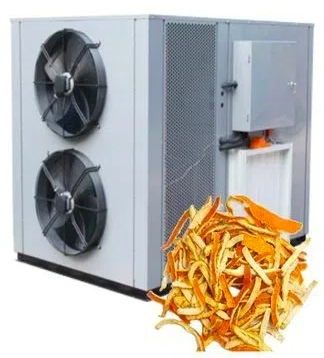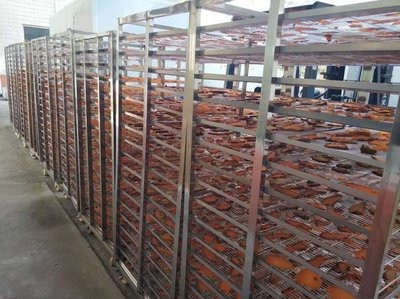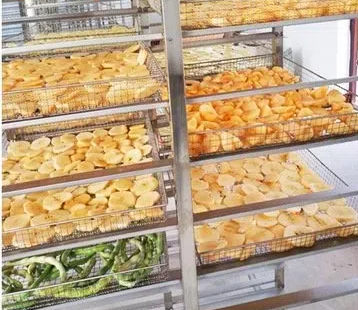
Content Menu
● Understanding Food Drying Technology
● The Benefits of Using Food Drying Machines
● How Heat Pump Dryers Work
● Comparing Heat Pump Dryers to Traditional Drying Methods
● Applications of Food Drying Machines
● The Future of Food Drying Technology
● Conclusion
● Frequently Asked Questions
>> 1. What is the main advantage of using heat pump technology in food drying?
>> 2. Can heat pump dryers be used for all types of food?
>> 3. How does the drying time compare between heat pump dryers and traditional methods?
>> 4. What maintenance is required for food drying machines?
>> 5. Are heat pump dryers suitable for small-scale operations?
In the world of food processing, drying is a crucial step that helps preserve food, enhance flavors, and extend shelf life. As a leading manufacturer of food drying machines in China, we specialize in providing OEM services to international brands, wholesalers, and producers. While our focus is on food drying technology, the principles of energy efficiency and advanced drying methods can be illustrated through the lens of AEG heat pump dryers, which are known for their energy-saving capabilities. This article will explore the technology behind food drying machines, their benefits, and how they compare to traditional methods, all while emphasizing energy efficiency.

Understanding Food Drying Technology
Food drying is a method of food preservation that removes moisture from food products, inhibiting the growth of bacteria, yeasts, and molds. There are several methods of drying food, including air drying, sun drying, and using specialized drying machines. Among these, food drying machines, particularly those utilizing heat pump technology, have gained popularity due to their efficiency and effectiveness.
Heat pump dryers work by transferring heat from the environment to the drying chamber, allowing for lower drying temperatures and reduced energy consumption. This technology is similar to that used in AEG heat pump dryers, which are designed to be energy efficient while providing excellent drying results.
The Benefits of Using Food Drying Machines
1. Preservation of Nutrients: One of the primary advantages of using food drying machines is the preservation of nutrients. Unlike traditional drying methods that may expose food to high temperatures, heat pump dryers operate at lower temperatures, helping to retain vitamins and minerals.
2. Enhanced Flavor: Drying food concentrates its flavors, making it more enjoyable. Heat pump technology allows for a controlled drying process, ensuring that the food maintains its natural taste.
3. Extended Shelf Life: By removing moisture, food drying machines significantly extend the shelf life of products. This is particularly important for businesses looking to reduce waste and improve profitability.
4. Energy Efficiency: As mentioned earlier, heat pump technology is designed to be energy efficient. This not only reduces operational costs but also minimizes the environmental impact of food processing.
5. Versatility: Food drying machines can be used for a wide variety of products, including fruits, vegetables, herbs, and meats. This versatility makes them an essential tool for food manufacturers and processors.
How Heat Pump Dryers Work
Heat pump dryers operate on the principle of thermodynamics, utilizing a refrigeration cycle to transfer heat. The process involves the following steps:
1. Evaporation: The heat pump extracts moisture from the food by evaporating it. This is done by circulating warm air around the food, which absorbs moisture.
2. Condensation: The moisture-laden air is then passed through a condenser, where it cools down, and the moisture condenses back into water.
3. Heat Recovery: The heat generated during condensation is recycled back into the drying chamber, enhancing energy efficiency.
4. Circulation: The cycle continues as the heat pump circulates warm air, ensuring even drying throughout the food products.
5. This closed-loop system not only conserves energy but also allows for precise control over the drying environment, ensuring optimal results.

Comparing Heat Pump Dryers to Traditional Drying Methods
When comparing heat pump dryers to traditional drying methods, several factors come into play:
1. Energy Consumption: Traditional drying methods, such as sun drying or hot air drying, often require more energy and can lead to higher operational costs. Heat pump dryers, on the other hand, use significantly less energy, making them a more sustainable choice.
2. Temperature Control: Traditional methods may expose food to fluctuating temperatures, which can affect the quality of the final product. Heat pump dryers provide consistent temperatures, ensuring uniform drying and better quality.
3. Moisture Control: Heat pump dryers excel in moisture control, allowing for precise adjustments based on the type of food being dried. This level of control is often lacking in traditional methods.
4. Labor Efficiency: Automated heat pump dryers reduce the need for manual labor, allowing businesses to streamline their operations and focus on other aspects of production.
Applications of Food Drying Machines
Food drying machines have a wide range of applications across various industries:
1. Snack Production: Dried fruits and vegetables are popular snacks. Heat pump dryers can produce high-quality dried snacks that retain their flavor and nutritional value.
2. Herb Drying: Culinary herbs can be dried efficiently, preserving their essential oils and flavors for use in cooking and seasoning.
3. Meat Preservation: Dried meats, such as jerky, require precise drying conditions to ensure safety and quality. Heat pump dryers provide the necessary environment for this process.
4. Pharmaceuticals: Some pharmaceutical products require drying to ensure stability and efficacy. Heat pump technology can be adapted for these applications.
5. Pet Food: The pet food industry also benefits from food drying machines, producing high-quality, nutritious dried food for pets.
The Future of Food Drying Technology
As the demand for dried food products continues to grow, the food drying industry is evolving. Innovations in technology are leading to more efficient and effective drying solutions. For instance, advancements in automation and smart technology are making it easier for manufacturers to monitor and control the drying process remotely. This not only improves efficiency but also enhances product quality.
Moreover, sustainability is becoming a key focus in food processing. Manufacturers are increasingly looking for ways to reduce their carbon footprint and minimize waste. Heat pump dryers, with their energy-efficient design, align perfectly with these goals. By investing in modern drying technology, businesses can not only improve their bottom line but also contribute to a more sustainable future.
Conclusion
In conclusion, food drying machines, particularly those utilizing heat pump technology, offer numerous advantages over traditional drying methods. Their energy efficiency, ability to preserve nutrients, and versatility make them an essential tool for food manufacturers and processors. As a leading OEM provider of food drying machines, we are committed to delivering high-quality products that meet the needs of our clients in the global market.

Frequently Asked Questions
1. What is the main advantage of using heat pump technology in food drying?
The main advantage is energy efficiency, as heat pump dryers use less energy compared to traditional drying methods while preserving the quality of the food.
2. Can heat pump dryers be used for all types of food?
Yes, heat pump dryers are versatile and can be used for a wide range of food products, including fruits, vegetables, herbs, and meats.
3. How does the drying time compare between heat pump dryers and traditional methods?
Heat pump dryers typically have longer drying times than traditional methods, but they provide better quality and nutrient retention.
4. What maintenance is required for food drying machines?
Regular cleaning and inspection of components, such as filters and fans, are essential to ensure optimal performance and longevity.
5. Are heat pump dryers suitable for small-scale operations?
Yes, heat pump dryers come in various sizes, making them suitable for both small-scale and large-scale food processing operations.












